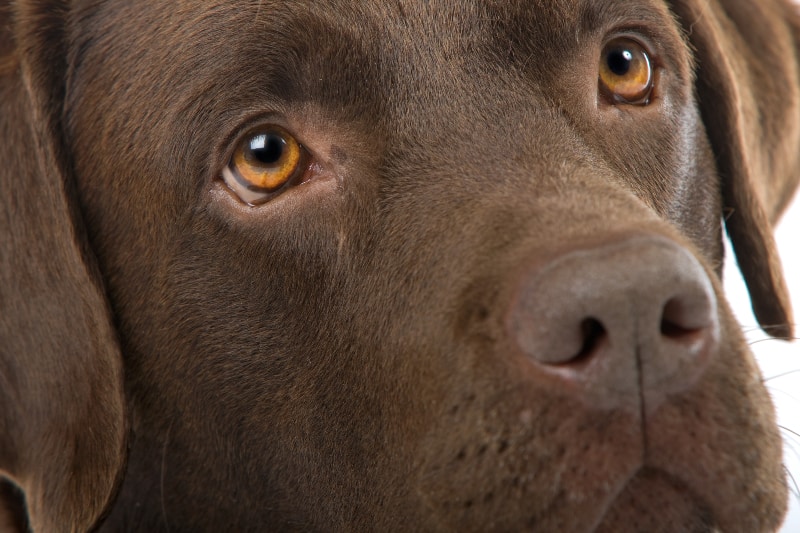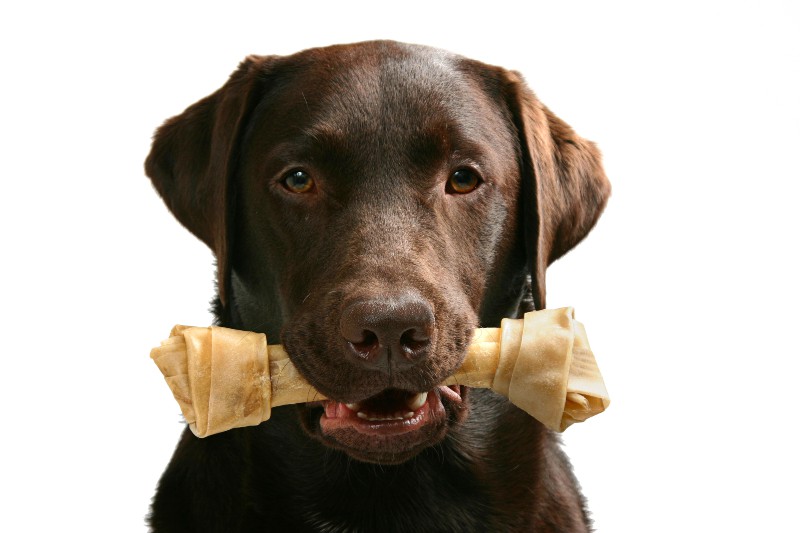
The Chocolate Labrador, with its irresistible charm and heartwarming presence, is more than just a dog. It’s an armful of unconditional love and enduring friendship. These dogs aren’t just animals. They’re storytellers, weaving tales of joy and companionship into the fabric of our lives.
Let me tell you, owning a Chocolate Lab is a unique experience. They’re not just smart; they get you. It’s like they can sense how you’re feeling and act accordingly. Whether you need a playful buddy or a calm friend to hang out with, they’re always there for you.
But did you know, the Chocolate Lab isn’t a separate breed? That’s right! They’re a color variant of the beloved Labrador Retriever, distinguished by their rich, chocolatey coat. This means they share the same great personality as their Labrador siblings, friendly, outgoing, and high-spirited, just with a different hue.
In this guide, I’m going to take you through everything about Chocolate Labs. I’ve spent a lot of time with these dogs, and I’m excited to share what makes them so special. From their history to how to take care of them, I’ve got loads of great info to share. Let’s dive in!
TABLE OF CONTENTS
- Chocolate Lab Quick Summary
- Origin and History of the Chocolate Labrador
- Chocolate Lab Physical Appearance
- Chocolate Lab Personality and Temperament
- Taking Care of a Chocolate Lab Dog
- Chocolate Lab Health Concerns
- The Cost of Owning a Chocolate Lab
- FAQs: All About Chocolate Labradors
- So, Is The Chocolate Lab the Right Dog For You?
Chocolate Lab Quick Summary
Origin and History of the Chocolate Labrador
The Labrador Retriever has a history as rich and interesting as its diverse color palette. Tracing its roots back to the rugged coastlines of Newfoundland, this breed has journeyed through time and geography, evolving into the beloved companion we know today.
Early Beginnings of the Labrador Retriever
The story of the Labrador Retriever begins in Newfoundland, Canada. Originally bred to help fishermen with tasks like retrieving fish and hauling nets, these dogs were sturdy, strong, and adept in water.
When these Newfoundlander dogs were brought to England in the 1800s, British breeders refined them into the breed we recognize today. This was the foundation for all Labrador Retrievers, a breed known for its versatility and intelligence.
The first official Labrador Retriever club was established in 1916, and the breed was recognized by the American Kennel Club in 1917.
Emergence of the Chocolate Color
Initially, Labradors were predominantly black or yellow, with the chocolate or liver color considered rare and less desirable. The chocolate color in Labradors is the result of recessive genes. For a long time, this color variant was overlooked by breeders.
In the mid-20th century, chocolate Labradors began to gain popularity. As understanding of genetics improved and public interest in varied coat colors grew, breeders started to appreciate and selectively breed for this unique hue.
Rising Popularity and Recognition
The late 20th century marked a significant rise in the popularity of Chocolate Labradors. Recognized for their beautiful coats and the same remarkable traits as their black and yellow counterparts, they began to gain prominence. This increase in popularity was reflected in dog shows, breeding programs, and media representation. The Chocolate Labrador started to be seen not just as a working dog but also as a desirable family pet.
Modern-Day Chocolate Labrador
Today, the Chocolate Lab is celebrated for its friendly nature, intelligence, and versatility. These dogs are no longer just popular as pets; they play crucial roles in various fields, including service and therapy work. They are beloved members of many families, known for their ability to form strong bonds and their adaptability to various lifestyles.
The Chocolate Labrador’s journey from obscurity to popularity is a testament to the breed’s enduring charm and the changing perceptions of dog lovers around the world.
Chocolate Lab Physical Appearance

Chocolate Labradors, let me tell you, are not just dogs. They’re like walking masterpieces of nature.
Their looks? Absolutely striking.
Every time I see one, I can’t help but be amazed by their physical presence. It’s like they’re the perfect blend of strength and beauty.
Size and Weight
So, how big are these gorgeous creatures? Well, they’re pretty solid, just like any Labrador. A male can weigh anywhere from 65 to 80 pounds, and they stand tall too, about 22 to 25 inches at the shoulder. Females are slightly smaller but still have that robust Lab build. Their weight ranges from 55 to 70 pounds while their height is 21.5 to 23.5 inches.
This large dog breed makes them fantastic for all sorts of activities, whether it’s going on a hike or just playing fetch in the backyard.
Coat
Now, let’s talk about their coat. It’s not just any brown, it’s this deep, rich chocolate color that practically glows in the sun. This is what distinguishes them from most Labradors.
And their coat so practical too! Water-resistant and thick, perfect for a dog that loves a good swim. I always find it amazing how their coat seems to repel water, a feature that harks back to their days assisting fishermen in Newfoundland.
Other Physical Features
And there’s more to them than just their size and coat.
They’ve got these broad heads with kind of an ‘I know what you’re thinking’ look. Their eyes are a warm brown, always alert and full of life. Plus, they’ve got this amazing tail, strong and sturdy – it’s like a built-in rudder for when they’re swimming.
Every part of them is just so well put together, from their strong legs to their expressive faces.
Chocolate Lab Personality and Temperament
Every time you cross paths with a Chocolate Labrador, there’s an unmistakable sense of warmth and liveliness that fills the air. These dogs carry a special aura around them, one that resonates with joy and exuberance. Their presence is like a burst of sunshine on a cloudy day, instantly lifting the spirits of everyone they meet
Friendly and Sociable
Just like any Labrador, Chocolate Labs are the epitome of friendliness. It’s like they’ve never met a stranger! Their sociable attitude makes them perfect family pets. They thrive on interaction, whether it’s with people or other animals.
I’ve often seen Chocolate Labs in the park, happily wagging their tails at everyone. They have this incredible ability to spread joy wherever they go, making them wonderful companions for all ages.
Eager to Please and Trainable
One thing I absolutely love about Chocolate Labs is their eagerness to please. This trait makes them highly trainable. Whether it’s basic commands or more complex tasks, they pick up things quickly. Their intelligence and desire to make their owners happy are truly remarkable.
High Energy and Playfulness
Let’s not forget, these dogs are bundles of energy! They’re as outgoing as any Labrador. They love to play and need regular exercise to keep them happy and healthy. From fetching balls to swimming, they’re up for anything.
Their playfulness isn’t just fun; it’s also a window into their joyful spirits. I’ve spent countless afternoons playing with Chocolate Labs, and their zest for life is downright infectious.
Loyal and Protective
They form deep bonds with their families and are known to be protective. However, they’re not overly aggressive; it’s more about being a steadfast companion. There’s a comforting sense of security that comes with having a Chocolate Lab in your home. They’re the kind of dogs that will always be by your side, through thick and thin.
Taking Care of a Chocolate Lab Dog

Caring for a Chocolate Lab, similar to taking care of any other Labrador, is an adventure that brings both joy and responsibility. It’s a journey that transforms a simple daily routine into an opportunity for bonding and learning. With every brush stroke, every meal prepared, and each step taken together on a walk, the bond between a dog and its owner deepens.
Grooming Needs
Their short, dense coat can shed heavily, especially during seasonal changes. Regular brushing, I’d say about once a week, helps keep their coat shiny and reduces the fur around the house.
And baths? They don’t need them too often, but it’s always a fun time when it happens.
Don’t forget the nails and ears – trimming nails monthly and keeping ears clean and dry is crucial for their health.
Diet and Nutrition
Feeding a Chocolate Lab is all about balance. These dogs can be quite food-motivated, which is great for training but can lead to overeating.
A high-quality diet tailored to their age, size, and activity level keeps them in top shape. I always advise measuring their food and sticking to a feeding schedule.
Chocolate Labrador Retrievers should be fed 2.5 to 3 cups of large dog kibble per day, split into two separate meals, with the exact portion size depending on age, weight, metabolism, activity level, and health.
And treats? Sure, but in moderation. It’s tempting to spoil them, but keeping an eye on their weight is important for their overall health.
Exercise and Physical Activity
Regular exercise is non-negotiable. Chocolate Labradors need at least two hours of exercise per day in the form of runs, walks, hikes, swims, and interactive games like frisbee. Dogs that aren’t exercised enough become bored and restless, which can lead to destructive behavior.
An active Lab is a happy Lab, so I always make time for their physical activities.
Training and Mental Stimulation
Training a Chocolate Lab is usually a joy. They’re quick learners and eager to please. Consistency and positive reinforcement work wonders.
Beyond basic commands, mental stimulation through puzzle toys or training games keeps their mind sharp. I’ve found that teaching them new tricks or engaging in dog sports can be rewarding experiences for both the dog and the owner.
Socialization and Emotional Health
Socialization is key from an early age. Exposure to different people, pets, and environments helps them develop into well-rounded dogs. Chocolate Labs are naturally sociable, but they still benefit from positive social experiences. Regular playdates and trips to dog-friendly spaces can be great.
And let’s not forget, they need love and attention. Spending quality time together strengthens the bond and keeps them happy.
Chocolate Lab Health Concerns
Just like any Labrador, they have their specific set of health issues owners need to be aware of. Knowledge is power, especially when it comes to spotting early signs and seeking timely treatment.
Hip Dysplasia
Hip dysplasia is a common issue I’ve seen in many larger breeds, including Chocolate Labs. It’s a genetic condition where the hip joint doesn’t fit together perfectly, which can lead to arthritis or discomfort. Keeping an eye on your dog’s exercise and weight can help manage this condition. Regular vet check-ups are key, as early detection can make a big difference.
Elbow Dysplasia
Similar to hip dysplasia, elbow dysplasia is about joint misalignment, but in the elbows. It can lead to pain or lameness. With proper treatment and adjustments in exercise, the affected dog can live a full and happy life. It’s about adapting and providing the right care.
Bloat
Bloat, or gastric dilatation-volvulus (GDV), is as serious as it sounds. It’s a sudden, life-threatening condition where the stomach fills with gas and sometimes twists. Knowing the signs, like a swollen abdomen or distress, is crucial. I always advise feeding Labs two smaller meals a day instead of one big one to help prevent this.
Diabetes
Yes, Labs can get diabetes too, especially with their love for food. Ensuring they have a well-balanced diet for diabetes and regular exercise. Regular vet check-ups are important to catch any signs early. Early detection and proper treatment can significantly improve the quality of life for diabetic dogs.
Osteochondritis Dissecans (OCD)
OCD in dogs is about abnormal cartilage development in their joints, leading to pain and stiffness. It can be managed with surgery or therapy, depending on the severity. I learned that keeping a Lab at a healthy weight and avoiding overexertion during their growth period can help reduce the risk.
Tricuspid Valve Dysplasia
This is a heart condition that some Chocolate Labs can inherit. It affects how blood flows through the heart. Regular veterinary monitoring can help manage this condition if it arises. A healthy lifestyle, as always, plays a big role in overall heart health.
Progressive Retinal Atrophy (PRA)
It involves the gradual deterioration of the retina, leading to blindness. There’s no cure, but most dogs adapt well to loss of vision if their environment remains consistent. I’ve seen Labs with PRA lead full, happy lives, thanks to the support and understanding of their owners.
The Cost of Owning a Chocolate Lab

Owning a Chocolate Labrador is not just a commitment of time and love; it also involves a financial commitment. While the initial cost of acquiring a Lab can vary widely, the long-term costs are what really add up over the life of your dog.
Let’s break down these expenses to give you a clear picture.
Initial Cost: Buying or Adopting
The initial cost can range significantly. Purchasing a Chocolate Lab from a reputable breeder might cost anywhere from $800 to $2,000, depending on lineage and location.
Meanwhile, the cost of a regular Labrador Retriever can range from $800 to $1,500. Chocolate Labs have rarer colors, which can make them slightly more expensive.
Adoption fees, if you choose to adopt from a shelter or rescue, are generally lower, ranging from $50 to $300. This fee often includes initial vaccinations and spaying/neutering.
Food and Treats
Feeding a Lab is a continuous expense. High-quality dog food tailored to their age, size, and activity level is crucial for their health. This can cost around $40 to $80 per month, depending on the brand and type of food. Don’t forget about treats for training and snacking, which can add another $10 to $20 monthly.
Veterinary Care
Regular vet visits for check-ups, vaccinations, and routine care are essential. Annual veterinary costs can range from $200 to $500. However, this doesn’t include unexpected illnesses or injuries, which can significantly increase this amount. Pet insurance can help manage these costs, with premiums typically ranging from $30 to $50 per month.
Grooming
While Chocolate Labs don’t require professional grooming as frequently as some breeds, you might still opt for occasional grooming sessions. This can cost around $30 to $60 per visit, depending on your location and the services provided. Basic grooming supplies for home, like brushes and nail clippers, will also add to the cost.
Training and Supplies
Initial training classes and supplies like a leash, collar, bed, and toys are part of the initial set-up. Training classes can range from $50 to $200 for basic obedience courses. Supplies can easily add up to a few hundred dollars.
Miscellaneous Expenses
Don’t forget about other costs like dog sitters or boarding facilities if you travel, which can be around $25 to $50 per day. There’s also the cost of heartworm and flea/tick prevention, which is roughly $100 to $200 annually.
FAQs: All About Chocolate Labradors
What is the average lifespan of a Chocolate Labrador?
Chocolate Labradors typically have a lifespan of 10 to 12 years. This can vary based on factors like genetics, health conditions, and the level of care they receive. Regular exercise, a healthy diet, and routine veterinary check-ups can help ensure they live a full and happy life.
Are there different types of Chocolate Labradors?
Yes, there are different types of Chocolate Labs, mainly categorized as American and English. American Chocolate Labs are leaner and more agile, often used in fieldwork. English Chocolate Labs are stockier with a calmer temperament, making them great family pets. Additionally, there are field and show lines, as well as working Chocolate Labs trained for specific tasks.
Can Chocolate Labs live in apartments?
While Chocolate Labs can adapt to apartment living, they are active dogs that require ample exercise. Daily walks, playtime, and regular trips to a park or open space are necessary. If they get enough exercise and mental stimulation, they can be comfortable in an apartment setting.
Are Chocolate Labs good with children?
Yes, Chocolate Labs are known for their friendly and gentle nature, making them excellent dog companions for children. However, as with any dog breed, interactions between dogs and young children should always be supervised.
Can Chocolate Labs live with other pets?
Absolutely! Chocolate Labradors are known for their friendly and sociable nature, making them great companions for other pets. They generally get along well with dogs, cats, and other animals, especially when properly introduced and socialized from a young age.
So, Is The Chocolate Lab the Right Dog For You?
Deciding if a Chocolate Labrador is the right dog for you involves understanding what fits best with your lifestyle and what you can offer to a dog. It’s about assessing not just your desire for a furry companion but also your ability to meet the needs of an energetic and affectionate breed.
Consider your daily routine, your living environment, and how much time and energy you can dedicate to caring for and engaging with your dog.
Remember, owning a Chocolate Lab is a commitment that extends beyond their adorable looks and into the realms of consistent training, exercise, and emotional bonding.
Chocolate Labs Are Suitable For
- Active Individuals or Families: If you love outdoor activities, long walks, or have a yard where a dog can play, a Chocolate Lab could be a great fit. They thrive in environments where they can expend their energy and stay active.
- Families with Children: Known for their gentle and friendly personality, Chocolate Labs usually do well in homes with children. They are patient and often enjoy the playful and affectionate interaction with younger family members.
- First-Time Dog Owners: Their trainability and forgiving nature make Chocolate Labs a good choice for first-time dog owners. They are adaptable and typically eager to please, which can make training a more straightforward process.
- People Looking for a Loyal Companion: If you want a dog that will be a devoted friend, ready to join you in every aspect of your life, a Chocolate Lab might be the one for you. They are known for their loyalty and companionship.
Chocolate Labs Are Not Suitable For
- Those with Limited Time for Exercise and Training: If your lifestyle doesn’t allow for daily walks, play sessions, and regular training, a Chocolate Lab might not be the best choice. They require regular physical and mental stimulation.
- People Seeking a Low-Energy or Independent Dog: Chocolate Labs are high-energy and often want to be involved in everything you do. If you prefer a more independent or low-energy dog, this breed might not align with your preferences.
- Individuals with Small Living Spaces and No Access to Outdoor Areas: While adaptable, Chocolate Labs do best when they have enough space to move around freely. A small apartment with no access to parks or outdoor areas might not be the most suitable environment for them.




Be the first to comment